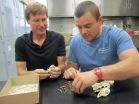(Press-News.org) One of the most widely used tools in epigenetics research - the study of how DNA packaging affects gene expression - is chromatin immunoprecipitation (ChIP), a technique that allows researchers to examine interactions between specific proteins and genomic regions. However, ChIP is a relative measurement, and has significant limitations that can lead to errors, poor reproducibility and an inability to be compared between experiments.
To address these issues, scientists from the University of Chicago have developed a new technique that calibrates ChIP experiments with an internal standard. The method, called Internal Standard Calibrated ChIP (ICeChIP), gives researchers an objective scale to assess ChIP measurements, enabling greater accuracy and reproducibility, better quality control and unbiased comparisons between experiments - which dramatically improves the accuracy of epigenetic studies and the development of therapeutics against diseases linked to epigenetic changes. ICeChIP is described in a paper published in Molecular Cell on June 4.
"Making accurate measurements has been impossible to do with ChIP before now," said senior author Alex Ruthenburg, PhD, assistant professor of molecular genetics and cell biology at the University of Chicago. "We see ICeChIP as an important step forward to measure real epigenetic phenomena in both experimental paradigms and patient samples."
For efficient cellular storage, DNA is typically spooled around histone proteins into complexes known as nucleosomes. Chemical modifications to histones - which are known to occur in response to cell signals or environmental conditions - can affect the expression of the underlying DNA. Although still poorly understood, these epigenetic changes are suspected to influence a variety of behavioral and health-related issues from cancer to cardiovascular disorders.
ChIP assays are the most commonly used tool to measure these changes. Central to the method are antibodies designed to bind to markers of interest, such as histone modifications. Antibodies allow researchers to extract specific histones and associated DNA from a general pool of genomic material gathered from cells or patient samples. These extracted complexes can then be sequenced and analyzed.
However, ChIP has several drawbacks. Commercial antibodies often have variable affinity, specificity and reproducibility when binding to markers of interest. Antibody quality cannot be measured within ChIP assays, which can lead to experimental errors. In addition, the data generated by ChIP are expressed on a relative scale. Coupled with variation in protocols, reagents, equipment and other factors, this makes comparisons between experiments challenging.
A new standard
Ruthenburg and his team tackled these issues by developing a method, dubbed ICeChIP, which adds an internal standard to ChIP assays, allowing results to be measured against an objective scale. They did so by designing semisynthetic nucleosomes - histones coupled to a variety of custom-synthesized DNA fragments. These fragments correspond to different DNA concentrations and act as barcodes that serve as a set of standards.
To use ICeChIP, semisynthetic nucleosomes are first engineered to represent the specific protein marker that a researcher is interested in. These nucleosomes are then added to the sample to be run. As antibodies extract the histone complexes and associated DNA of interest, ICeChIP nucleosomes are also extracted. During analysis, the synthetic DNA barcodes are identified and used to generate a calibration curve. This allows researchers to calculate the efficacy and specificity of the antibody used in the experiment, and to calculate the true amount of histones containing the marker of interest across the whole genome.
"What we've done is make the numbers produced by ChIP experiments correspond to something real," Ruthenburg said. "By putting in an internal standard in the experiment, we tether all our measurements to that standard. Not only can this be reproduced and compared, we're finally able to measure how much of a modification is present at a given spot in the genome instead of relative amounts."
The researchers tested the efficacy of ICeChIP by measuring H3K4me3 modifications, a well-known epigenetic marker, in mouse and human stem cells. Samples were spiked with a small amount of synthetic nucleosomes and then run in ChIP assays. The team identified that roughly two percent of all histones expressed this marker, a number corroborated by mass spectrometry, radiolabeling experiments and other independent tests. Reproducibility was tested by simulating experimental handling disparities, and the results were found to be stable over multiple trials.
They also used ICeChIP to measure a variety of other common histone modifications, and made surprising findings. They discovered that roughly a third of all genes in stem cells are associated with both activating and deactivating histone modifications - a phenomenon known as bivalency. This was thought to be a regulatory mechanism for development, but unproven until now. Ruthenburg and his team found that bivalency is indeed a real characteristic, but its pervasiveness throughout the genome calls into question its role in developmental genetic regulation.
"Our work measures bivalency for first time at the genome scale, and its prevalence suggests that it is not as specialized as previously thought," Ruthenburg said.
The team also found that the efficacy of commonly-used antibodies for certain histone markers - specifically for H3K36me3 and H3K79me2 modifications - had poor specificity. As these antibodies have been used in hundreds of published studies and have led to the development of therapeutics undergoing clinical trials, additional studies to validate previous results could be required.
"We are deeply concerned that some of the measurements out there for these marks are far more noise than signal," Ruthenburg said.
The team are now working to extend ICeChIP toward other histone and protein markers, improve its suitability for commercial use and investigating ways to utilize it in the development of diagnostic assays for human diseases.
INFORMATION:
The study, "Calibrating ChIP-Seq with Nucleosomal Internal Standards to Measure Histone Modification Density Genome Wide," was supported by the National Institutes of Health, the Chicago Biotechnology Consortium with support from The Searle Funds at The Chicago Community Trust and the Ellison Foundation. Additional authors include Adrian T. Grzybowski and Zhonglei Chen.
About one-third of patients admitted to an intensive care unit (ICU) will develop delirium, a condition that lengthens hospital stays and substantially increases one's risk of dying in the hospital, according to a new study led by Johns Hopkins Medicine researchers appearing in the British Medical Journal.
"Every patient who develops delirium will on average remain in the hospital at least one day longer," says one of the study's authors, Robert Stevens, M.D., a specialist in critical care and an associate professor at the Johns Hopkins University School of Medicine. ...
[EMBARGOED UNTIL THURSDAY, JUNE 4] Although treatment advances have dramatically reduced deaths from opportunistic infections related to AIDS, a new study drawing on 30 years of data from more than 20,000 patients in San Francisco suggests there is still ample room to improve. About a third--35 percent--of AIDS patients diagnosed with their first opportunistic infection from 1997 to 2012 in that city died within five years, according to the study, published in the Journal of Infectious Diseases.
"While recent research suggests that many opportunistic infections in the ...
Philadelphia, PA, June 4, 2015 - Children with Autism Spectrum Disorder (ASD) are often picky eaters, which can lead parents to suspect that their children might not be getting adequate amounts of vitamins and minerals. This sometimes leads parents of children with ASD to try nutritional supplements and dietary regimens such as gluten-free and casein-free (GFCF) diets without professional supervision. In the largest study of its kind, published in the Journal of the Academy of Nutrition and Dietetics, researchers report that these well-intentioned efforts can result in ...
In a new study, scientists have gathered all available NASA/ESA Hubble Space Telescope data on the four outer moons of Pluto to analyse the system in more depth than ever before. The observations show that at least two of Pluto's moons are not neatly rotating on their axes but are in chaotic rotation while orbiting around Pluto and its companion Charon. The study also hints that one of the moons has a mysterious jet-black colouring. These surprising results appear in the 4 June issue of the journal Nature.
Almost every moon in the Solar System, including our moon, rotates ...
SALT LAKE CITY, June 4, 2015 - At times during the past 10,000 years, cottontails and hares reproduced like rabbits and their numbers surged when the El Niño weather pattern drenched the Pacific Coast with rain, according to a University of Utah analysis of 3,463 bunny bones.
The study of ancient rabbit populations at a Baja California site may help scientists better understand how mammals that range from the coast to the interior will respond to climate change, says anthropology doctoral student Isaac Hart. He is first author of the study to be published in the ...
A rare and elusive rabbit has been found, held and photographed by a researcher from the University of East Anglia (UEA).
The Annamite Striped rabbit, found in the forests of Laos and Vietnam, was first documented by rabbit expert Dr Diana Bell and colleagues from UEA's School of Biological Sciences in the journal Nature in 1999. It has rarely been seen since.
Researcher Sarah Woodfin, who is studying for a Masters in Applied Ecology and Conservation at UEA, set out on a three-month expedition to track the recently-discovered rabbit and study its habitat.
But she ...
Many aquatic species have a reputation for negligent parenting. Having cast their gametes to the currents, they abandon their offspring to their fate. However, hands-on parenting is taken to a whole new dimension in the Syngnathidae fish family. Instead of leaving the responsibility to the females, seahorse and pipefish males take the pledge to care for their young even before the eggs are fertilized. The females depart soon after placing their eggs directly into the male's brood pouch, leaving the soon-to-be fathers to incubate the developing embryos. Ines Braga Goncalves ...
Cancer has overtaken cardiovascular disease, which includes heart disease and stroke, as the UK's No 1 killer--but only among men, reveals research published online in the journal Heart.
Cardiovascular disease is still the most common cause of death among women, and kills more young women than breast cancer, the figures show.
The researchers used the latest nationally available data (2012-13) for each of the four UK countries and the Cardiovascular Disease Statistics 2014 report compiled for the British Heart Foundation (BHF) to quantify the prevalence of cardiovascular ...
Researchers have developed a score that predicts an individual's risk of dying within 5 years for people aged between 40 and 70 years old in the UK, according to new research published in The Lancet.
The score, which uses measures that can be obtained by simple questionnaires without any need for physical examination, such as self-rated health and usual walking speed, could be used by individuals to improve awareness of their health status, and by doctors to identify high-risk individuals for further treatment, say the authors.
Individuals can calculate their personalised ...
Women aged 50-69 years who attend mammography screening reduce their risk of dying from breast cancer by 40 per cent compared to women who are not screened - according to a major international review of the latest evidence on breast cancer screening.
Overall, women who are invited to attend mammography screening have a 23 per cent risk reduction in breast cancer death (owing to some attending and some not), compared with women not invited by routine screening programmes.
In the UK, this relative risk translates to around eight deaths prevented per 1,000 women regularly ...

